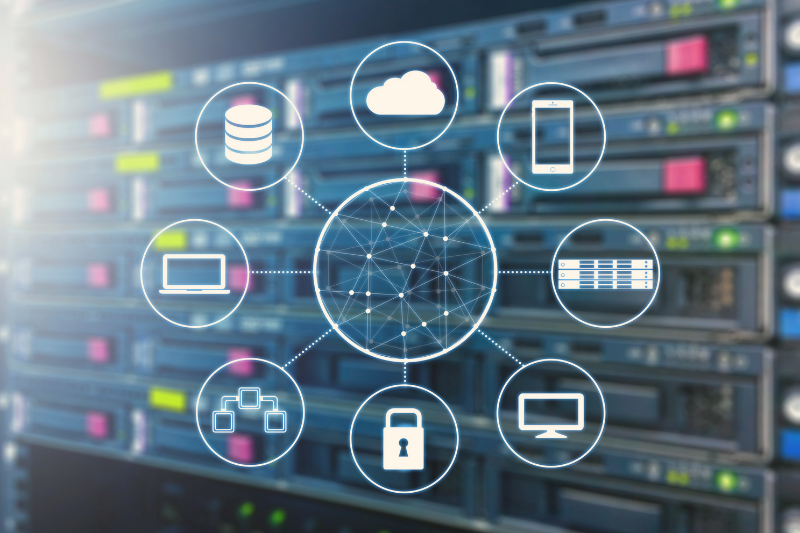For businesses of all sizes, data security and continuity are of critical importance. Data loss can disrupt business operations, lead to financial losses, and damage customer trust. That’s why choosing the right data protection strategy is a vital decision for every organization. To guard against adverse scenarios, two primary data protection methods stand out: backup and replication. While both help prevent data loss, their purposes and implementations differ significantly.
In this blog post, we’ll explore the key differences between backup and replication. Backup ensures that data is copied at regular intervals and can be restored in the event of data loss. Replication, on the other hand, focuses on real-time copying of data to enable immediate access. Each method offers its own advantages, but choosing the one that fits your business needs will help you protect your data most effectively.
Understanding backup and replication methods will help you determine which solution is best suited for your organization. By examining both approaches and their differences, you can develop a data protection strategy tailored to your business requirements.
Backup: Key Features and Benefits
Data backup is a fundamental strategy for protecting digital information and providing a reliable recovery path in case of data loss. The backup process involves regularly copying data and storing these copies in a secure environment. This method helps prevent data loss and supports the continuity of your business operations.
Types of Backup and Their Features
Full Backup: This method copies and stores all your data at once. Full backups simplify and speed up the recovery process, as all data is stored in a single backup. However, they generally require more storage space and time.
Incremental Backup: Only data that has changed since the last full or incremental backup is copied. This method uses storage and time more efficiently. However, restoring data may require combining multiple backups, which can be more complex.
Differential Backup: Copies all data that has changed since the last full backup. It may require more storage than incremental backups, but the recovery process is usually simpler.
Advantages of Backup
Backup is a cornerstone of any business’s data security strategy. Businesses of all sizes can safeguard their data and be prepared for potential data loss scenarios.
Reduces the risk of data loss: Regular backups ensure your data can be restored in case it’s lost. This minimizes data loss caused by system failures, human error, or malware.
Enables easy recovery: Backup strategies allow for fast and efficient recovery during data loss, helping maintain business continuity.
Offers flexibility and scalability: Backup solutions can be customized to fit your data needs, making them suitable for both small businesses and large enterprises.
Provides historical data access: Backups allow retrieval of data from specific points in time, helping you correct past errors or recover lost files.
Replication: Key Features and Benefits
Data replication involves creating multiple copies of data and storing them in different locations. This method ensures high data availability and continuity while minimizing the risk of data loss. Replication is commonly used in large-scale systems and environments where critical data is involved.
Types of Replication and Their Features
Synchronous Replication: Ensures that when data is written, it is instantly and simultaneously replicated to all designated locations. This guarantees that the data is always consistent and up to date but may impose some performance overhead due to the immediate transfer of all data.
Asynchronous Replication: Transfers data to replication points with a delay after the data is written. This can improve performance and network efficiency but may increase the risk of data loss, as replication is not immediate.
Hybrid Replication: Combines both synchronous and asynchronous methods. It aims to balance data security and performance, but often requires a more complex setup.
Advantages of Replication
Replication plays a critical role in data security and business continuity. Both synchronous and asynchronous replication methods ensure data availability and can be tailored to different performance requirements.
Ensures high availability: Replication allows data to be stored in multiple locations, providing rapid access and continuity during system failures or data loss. Data remains accessible and usable at all times.
Delivers high performance: Asynchronous replication allows faster data writing since synchronization occurs in the background, boosting overall system performance.
Plays a key role in disaster recovery: Replication enables fast recovery in the event of data loss. Since data is stored in different locations, the recovery process can be more efficient during disaster scenarios.
Ensures data consistency: Synchronous replication ensures all data copies are always consistent and up to date, which is especially critical for sensitive financial or operational data.
Supports business continuity: Replication enables uninterrupted operations during data loss or system failure, helping businesses provide continuous service.
Key Differences Between Backup and Replication
Backup and replication are two essential data protection methods. While both aim to ensure data security and continuity, they differ in function and benefits.
Which solution a business should choose depends on its specific needs and risk profile. Backup is ideal for preventing data loss and offering long-term protection, while replication is better suited for continuous access and high availability. Using both methods together can create a comprehensive data protection strategy and offer maximum security.
Definitions and Key Features
Backup involves copying data at regular intervals and storing it securely, allowing restoration in case of data loss. It typically includes full, incremental, and differential strategies depending on the scenario.
Replication, on the other hand, is the process of continuously maintaining updated copies of data in multiple locations. The type of replication determines how and when data is synchronized. Synchronous replication updates data instantly, while asynchronous replication updates it after a delay. Hybrid replication combines both to provide flexibility and performance balance.
Process Flow and Data Updates
Backups are performed at scheduled intervals and used to restore data in case of loss. This allows recovery of past data states but does not preserve the exact moment of loss.
Replication continuously updates data, always keeping a live copy available. Synchronous replication updates both locations simultaneously, increasing consistency. Asynchronous replication offers performance benefits but carries the risk of slightly outdated copies.
Scope and Application Areas
Backups are typically used for long-term data protection and play a critical role in disaster recovery scenarios. They involve scheduled processes designed to minimize data loss.
Replication is more suitable for applications that require continuous access and high availability. It is especially preferred for real-time data operations and scenarios that demand low latency.
Choosing the Right Solution: What to Consider
To define the right data protection strategy, it’s essential to clearly outline your business needs and data protection goals. Once you understand the differences between backup and replication, you can decide which solution best serves your data security and accessibility requirements. Both methods can play a vital role in your data protection strategy and offer a robust solution for enhanced data security.
Identify Your Business Needs
When choosing a data protection solution, it’s important to consider your business’s unique needs and risk profile. Backup and replication serve different use cases, and each has advantages optimized for specific scenarios. Start by assessing your data access requirements, business continuity goals, and tolerance for data loss.
When Is Backup the Right Choice?
If your business needs to restore data in the event of loss and aims for long-term protection, backup may be the most suitable option. Backup plays a critical role in disaster recovery and ensures data is copied regularly. This reduces the risk of data loss and provides flexibility during recovery.
When Is Replication the Right Choice?
Replication should be preferred for applications that require constant access and high availability. If your data must always be up to date and accessible, replication is a strong choice. Synchronous replication offers real-time updates and high data consistency, though it may affect performance. Asynchronous replication provides performance advantages but may introduce delays in data updates.
Hybrid Solutions and Integration
Many businesses combine backup and replication to strengthen their data protection strategies. Hybrid solutions ensure both continuous access and long-term protection. This combination is ideal for meeting high availability and data security requirements.
Synchron’s Backup and Replication Solutions
Synchron offers comprehensive backup and replication solutions designed to safeguard your data and support business continuity. These customizable solutions reduce the risk of data loss while improving operational efficiency.
Local Backup: Instant Access and Maximum Security
Synchron’s local backup service allows you to securely store your data on physical media. This minimizes the risk of data loss and ensures fast, uninterrupted access to your information. Your business data remains at your fingertips, and recovery is immediate in case of loss.
Office 365 Backup: Support Your Business Continuity
To optimize your Office 365 usage and prevent data loss, you can rely on Synchron’s automated backup service. This service regularly backs up your Office 365 data, supporting your business continuity and enhancing data security. It provides strong protection against any kind of data loss.
Cloud Backup: Protect Against Disasters
Synchron’s cloud backup solutions enable you to securely store your data in the cloud. This minimizes data loss risk in disaster scenarios and works in full integration with your IT infrastructure. Cloud backup offers flexibility and scalability, securing your data while boosting operational continuity.
Disaster Recovery – Disaster as a Service (DRaaS): Ensure Uninterrupted Operations
For fast and effective response in the face of disasters, you can choose Synchron’s Disaster as a Service (DRaaS) solution. This service helps restore your operations as quickly as possible without interruption. Synchron offers comprehensive disaster recovery plans to maintain your business continuity.
Make the Right Choice for Your Data Security with Synchron
Choosing between backup and replication is a strategic decision for your data security. However, each method has its unique advantages and application areas. Selecting the solution that best fits your business needs minimizes data loss risks and boosts your operational efficiency.
Which solution is right for you? When deciding between backup and replication, consider your business workflows and data security requirements. It’s important to weigh the benefits and limitations of both methods to make a strategic decision that suits your needs.
At Synchron, we’re here to offer your business the most suitable backup and replication solutions. Our expert team provides professional advice on protecting your data and ensuring business continuity. Whether you need cloud-based backups or disaster recovery services, our tailored solutions will maximize your data security.
Contact Synchron to define your future data security strategy and choose the best solution for your business. We’re here to help you develop the optimal backup and replication strategy that fits your needs.
İletişim Bilgilerinizi Bırakın, Size Hemen Ulaşalım!
Synchron destek ekibine 7/24 erişebilir ve her sorununuza kısa süre içinde çözüm bulabilirsiniz.
Telefon: +90 216 978 81 91



